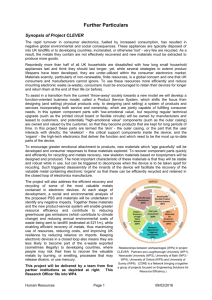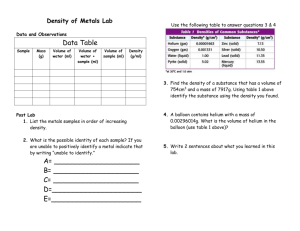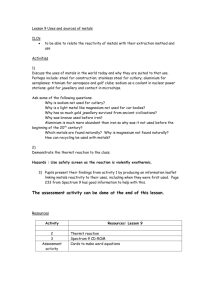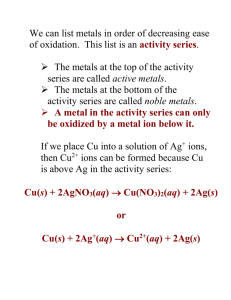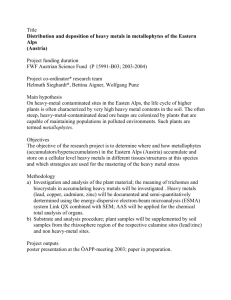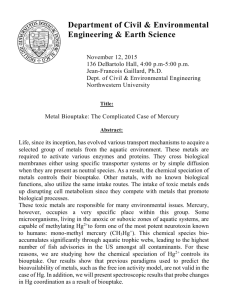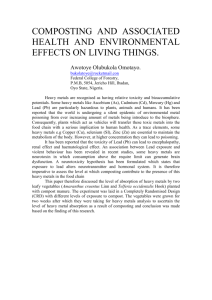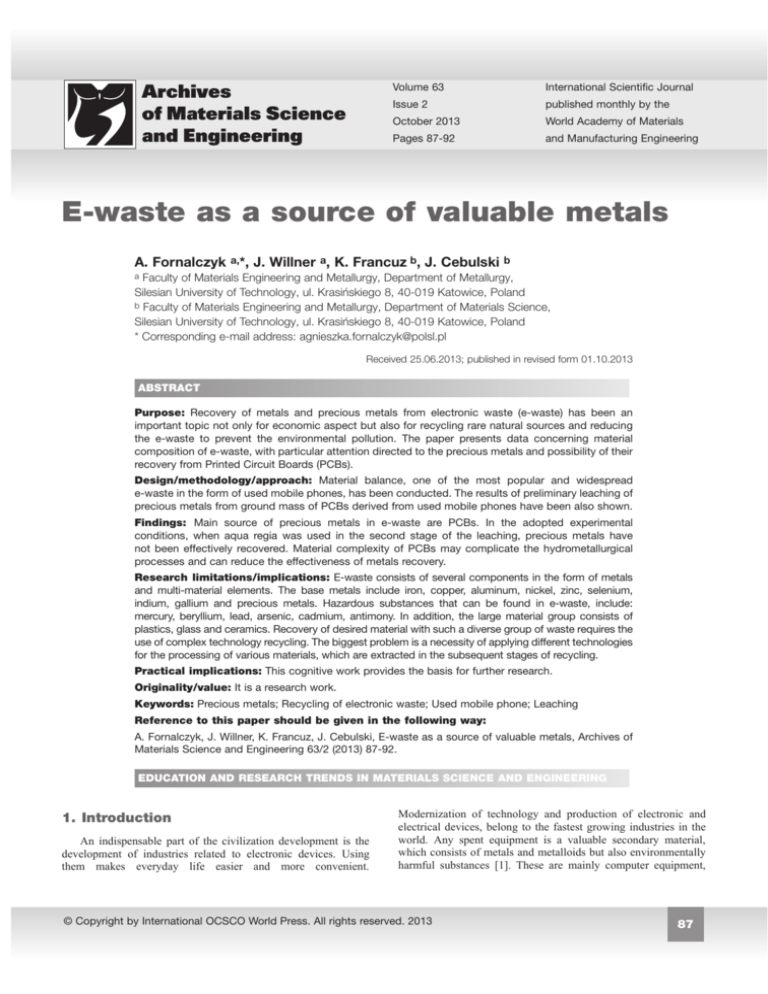
Volume 63
International Scientific Journal
Issue 2
published monthly by the
October 2013
World Academy of Materials
Pages 87-92
and Manufacturing Engineering
E-waste as a source of valuable metals
A. Fornalczyk a,*, J. Willner a, K. Francuz b, J. Cebulski
b
a
Faculty of Materials Engineering and Metallurgy, Department of Metallurgy,
Silesian University of Technology, ul. Krasińskiego 8, 40-019 Katowice, Poland
b Faculty of Materials Engineering and Metallurgy, Department of Materials Science,
Silesian University of Technology, ul. Krasińskiego 8, 40-019 Katowice, Poland
* Corresponding e-mail address: agnieszka.fornalczyk@polsl.pl
Received 25.06.2013; published in revised form 01.10.2013
ABSTRACT
Purpose: Recovery of metals and precious metals from electronic waste (e-waste) has been an
important topic not only for economic aspect but also for recycling rare natural sources and reducing
the e-waste to prevent the environmental pollution. The paper presents data concerning material
composition of e-waste, with particular attention directed to the precious metals and possibility of their
recovery from Printed Circuit Boards (PCBs).
Design/methodology/approach: Material balance, one of the most popular and widespread
e-waste in the form of used mobile phones, has been conducted. The results of preliminary leaching of
precious metals from ground mass of PCBs derived from used mobile phones have been also shown.
Findings: Main source of precious metals in e-waste are PCBs. In the adopted experimental
conditions, when aqua regia was used in the second stage of the leaching, precious metals have
not been effectively recovered. Material complexity of PCBs may complicate the hydrometallurgical
processes and can reduce the effectiveness of metals recovery.
Research limitations/implications: E-waste consists of several components in the form of metals
and multi-material elements. The base metals include iron, copper, aluminum, nickel, zinc, selenium,
indium, gallium and precious metals. Hazardous substances that can be found in e-waste, include:
mercury, beryllium, lead, arsenic, cadmium, antimony. In addition, the large material group consists of
plastics, glass and ceramics. Recovery of desired material with such a diverse group of waste requires the
use of complex technology recycling. The biggest problem is a necessity of applying different technologies
for the processing of various materials, which are extracted in the subsequent stages of recycling.
Practical implications: This cognitive work provides the basis for further research.
Originality/value: It is a research work.
Keywords: Precious metals; Recycling of electronic waste; Used mobile phone; Leaching
Reference to this paper should be given in the following way:
A. Fornalczyk, J. Willner, K. Francuz, J. Cebulski, E-waste as a source of valuable metals, Archives of
Materials Science and Engineering 63/2 (2013) 87-92.
EDUCATION AND RESEARCH TRENDS IN MATERIALS SCIENCE AND ENGINEERING
1.
Introduction
1. Introduction
An indispensable part of the civilization development is the
development of industries related to electronic devices. Using
them makes everyday life easier and more convenient.
Modernization of technology and production of electronic and
electrical devices, belong to the fastest growing industries in the
world. Any spent equipment is a valuable secondary material,
which consists of metals and metalloids but also environmentally
harmful substances [1]. These are mainly computer equipment,
© Copyright by International OCSCO World Press. All rights reserved. 2013
87
A. Fornalczyk, J. Willner, K. Francuz, J. Cebulski
household appliances, television and radio, cell phones. Discarded
appliances are not segregated and often all go to the landfill.
Among the e-waste in Poland [2]:
x 35-76% is a computer equipment and TV,
x 22-54% is a small electronic equipment,
x 18-25% is a telephone equipment,
x 5-15% is other waste.
2.
aterial composition
of electronic
2. MMaterial
composition
of electronic
waste
waste
Spent electronic equipment consists of several components in
the form of metals and multicomponent elements. The base metals
include iron, aluminum, nickel, zinc, selenium, indium, gallium.
The noble metals can be divided into copper, palladium or gold,
silver. Hazardous substances that can be found in spent electronic
equipment, include: mercury, beryllium, lead, arsenic, cadmium,
antimony and plastics, glass and ceramics. Depending on many
factors, such as the age of the device, manufacturer, the type of
equipment, the content of the individual electronic component in
the waste is mixed. Table 1 shows selected material composition
of the electronic devices. A decisive impact on the value of
electronic scrap has the content of PGMs (Precious Group
Metals). Although iron and plastic are dominate components (in
terms of weight - Table 1), a seemingly small content of precious
metals in different electronic devices (<0.5%), constitutes about
the electronic scrap value (Table 2) [3]. Analysing only computer
equipment and mobile phones, this share is 3% of the world
production for Ag, 4% for Au and 16% for Pd.
Table 1.
Selected material composition of electronic devices [4-6]
Contents, %
Contents, ppm
TYPE OF
DEVICE
Fe
Al
Cu Plastic
Ag
Au
Pd
TV board
PC board
Mobile
phone
DVD
Calculator
e-waste
30
7
15
5
10
18
28
23
280
900
20
200
10
80
7
3
13
43
3000
320
120
62
4
8,3
2
5
0,71
5
3
8,5
24
61
-
115
260
290
15
50
124
4
5
-
Table 2.
The value of selected components in electronic equipment (in
terms of prices of 2010) [4]
Value - share, %
TYPE OF
Precious
DEVICE
Fe Al Cu
metals
Ag Au Pd
(sum)
TV board
4
14 35
47
7
33
7
PC board
0
1
13
86
5
69 12
Mobile phone
0
0
6
93
11
71 11
DVD
15
3
30
52
5
42
5
Calculator
1
4
10
85
6
76
3
88
88
3.
ecycling ofofelectronic
3. RRecycling
electronicwaste
waste
The waste electrical and electronic equipment (WEEE)
includes diverse equipment in the form of: monitors and TV sets,
computers, lighting equipment, household appliances, printers and
phones. The raw materials used to produce them are a mixture of
metals and their alloys, plastics, glass, paper, wood, ceramics and
rubber. Recovery of desired material with such a diverse group of
waste requires the use of complex technological recycling. The
biggest problem is a necessity of applying different technologies
for the processing of various materials, which are extracted in the
subsequent stages of recycling. From WEEE it is possible to
recover valuable precious metals such as platinum, gold, silver,
rhodium or palladium. Steel is most frequently recovered (in
amount about 50%) but aluminum so is (from 10 to 30%) and
copper and its alloys (from 15 to 45%). The initial stage of WEEE
recycling is the manual removal of steel and aluminum as well as
a large number of items containing precious metals. In this stage,
casings made from plastics, kinescopes and printed circuit boards
are separated. The most difficult materials for the processing are
plastic casings that contain a mixture of several polymers and
substances providing non-flammable parts. Processing of this type
of material is limited to grinding [7].
Separated scrap is a mixture of aluminum and steel as well as
elements that contain a high concentration of noble metals.
Particularly, rich in these ingredients (precious metals) are
printed circuit boards (PCBs). PCBs can be returned to their reuse or subjected to grinding and recovery of non-ferrous and
precious metals in traditional metallurgical processes. These
technologies consist of a combination of pyro- and
hydrometallurgical methods [7,8]. In addition to traditional
methods of electronic waste processing, new solutions for the
efficient
recovery
of
metals
are
being
sought.
Biohydrometallurgical methods using a variety of microorganisms
in biological leaching of metals may become a promising method
applied in the future [9,10].
3.1.Mobile
phone recycling
recycling
3.1 Mobile phone
Over the past 30 years, mobile telephony has become one of
the fastest growing technology and currently the cell phone is the
most popular and widely used personal communication device in
the world. Report of the International Telecommunications Union
says that the number of mobile users in 2011 reached 6 billion.
This means that the 86 persons per 100 possess the mobile phone
[11]. The specific and dominant feature of the mobile phone
market is a very fast marketing of the product and its replacement.
The estimated life time of a mobile decreased from 3 years in
1991 to 18 months in the year 2006 and it is assumed that the
current time may be even shorter [12]. Unfortunately, useless or
obsolete mobile is stored by users in drawers. According to the
global survey conducted by Nokia in 2008 [13] only 3% of users
give away their mobile phones for recycling. Most of the old
equipment (44%) is not used any more. Others, however, get a
new "life": one per four of the old phones are given to friends and
family members, and 16% is sold as spare parts - especially in
developing countries.
Archives of Materials Science and Engineering
E-waste as a source of valuable metals
Table 3.
Mobile phone components [14,15]
Element description
Table 4.
Substances contained in mobile phones [14]
Element view
Printed circuit boards (PCBs)
A circuit made mostly of copper is soldered to
the board with protective coatings and adhesives.
The board is made of epoxy resin or fibreglass
and generally coated with gold. Solder joints are
made on silver-plated copper contacts. On the
PCBs there are plastic, metal and ceramic
housing components. Precious metals and other
hazardous substances in the PCBs are Pd, Ag,
As, Sb, Be, Br, Cd, Pb, Ni, Tl, Zn.
Liquid Crystal Display (LCD)
The LCD contains liquid crystals which are
embedded between layers of glass. The liquid
crystalline substances can contain toxic
substances such as mercury. A typical mobile
phone contains several mg of liquid crystal
substance.
Battery
The battery enclosed in a sealed plastic housing
can belong to one of three types: lithium-ion
(Li-ion), nickel-metal-hydride (NiMH), nickelcadmium (Ni-Cd) batteries - batteries present in
the older types of phones, which are still in
circulation.
Plastic Casing
The plastic material used to case the phone
together is usually polycarbonate (PC),
acrylonitrile butadiene styrene (ABS) or a
combination of the two.
Other Components
Antenna, speaker, microphone, keypad,
accessories - most of these components are
very small and contain various elements in
terms of material composition: metallic and
non-metallic elements.
Charger
The chargers mainly consist of copper wires
encased in plastic, but materials such as gold,
cadmium and brominated flame retardants may
also be present.
Mobile phone consists of a few basic elements: casing,
display, keypad, printed circuit board, antenna, microphone,
speaker, battery and charger. Description of the components of a
mobile phone is shown in Table 3. In terms of material
composition a cell phone does not differ from other electronic
devices and contains a number of different elements made of
metals, plastics, glass and ceramics. Depending on the design,
manufacturer, model and age of the phone the content of these
components in the phone may vary. In most cases, phone plastic
casing, in certain models could be made from aluminum or
magnesium but also different substances and additives may be
used by different manufacturers in electronic circuits.
Volume 63
Issue 2 October 2013
Conten
t [%]
Substance
Plastics
Glass, ceramics
Location in mobile phone
Primary Constituents
~40
Case, PCB
~20
LCD screen, chips
Cu, compounds
~10
PCB, wires, connectors,
batteries
Ni, compounds
KOH
Co
C
Al
~2-10*
<5*
1-5*
<5
~3- 20
NiCd or NMH batteries
battery, NiCd, NiMH
Lithium-ion battery
Bateries
Case, frame, batteries
Steel, ferrous
metal
~10
Case, frame, charger, batteries
Sn
~1%
PCB
Minor constituents 0.1% - 1%,
Br, Mg, Ta, W, Zn
Cd
Cr
Pb
Li
Ag
PCB
NiCd batteries
Case, frame
PCB; used in a tin-lead solder, which
very efficiently bonds components into
integrated electronic devices. Small
quantities of lead compounds are used in
some plastics, although it is gradually
phased out. Lead is still used extensively
in PVC coated wires (2–5%) and this use
of lead is not phased-out yet. Most new
mobile phones do not contain lead based
solder; however, older end-of-life mobile
phones that are sent for material
recovery may contain lead based solder.
Lithium-ion battery
PCB, keypad
Micro or trace constituents < 0.1%
Sb, Bi, Ca, Ba. Pd,
Ru, Sr, S, Y, Zr,
As
Be
F
Ga
Au
Mg
PCB
Gallium arsenide LED
Connectors
Lithium-ion Battery
Gallium arsenide LED
Connectors, PCB
If Mg is used for phone cases, its amount
would be much bigger ~20%
No current use of mercury in mobile
phones is known. However, certain old
Hg
mobile phones may contain mercury
oxide or silver oxide button cell batteries
with mercury content.
*only if these battery types are used, otherwise minor or micro
constituent
89
A. Fornalczyk, J. Willner, K. Francuz, J. Cebulski
Mobile phone can contain more than 40 elements, including
the basic metals (Fe, Cu, Al, Ni, Zn, Sn), precious metals (Au,
Ag, Pt, Rd) or dangerous ingredients (Be, Cd, As, Sb).
Table 4 shows the typical content of an average mobile phone
components, systematized in three categories: primary
constituents, minor constituents and micro or trace constituents
along with their location in the phone. A statistic mobile phone
consists of 40% plastic, 20% glass and 23% of metals. Therefore
spent mobile phones are a useful source of metals, including
copper, other non-ferrous metals and precious metals like gold,
silver and palladium.
Figure 1 shows the general scheme of the recycling chain and
material recovery from used mobile phones, including metals.
Accelerating voltage applied during the observation and X-ray
microanalysis was 15 kV. Microanalysis of the chemical
composition was performed by EDS method (Energy Dispersive
Spectrum) (see Figures 2-4 and Table 5).
The weight of each part of the phone is shown in Table 6 and
the initial and final results of the analysis of copper, silver and
gold in the material of the test are shown in Table 7.
Fig. 2. Structure of PCB with marked selected areas for X-ray
energy spectra
Fig. 1. Flow diagram - recovery of metals and other materials
from mobile phones [14]
Fig. 3. Microanalysis of the chemical composition by EDS
method-pt 1
4.
Experiments
4. Experiments
4.1.Materials
4.1. Materials and
and methods
methods
The study was carried out in the laboratory at the Faculty of
Metallurgy, Department of Materials Science and Metallurgy,
Silesian University of Technology. In the research, spent mobile
phone the Samsung M351, was used. The phone was
disassembled. In order to homogenise the structure, the phone was
milled in a ball mill-tumbler. Analysis of the content of metals
was performed on an atomic absorption spectrometer ASA. The
surface of the PCB sample was also analysed by using a scanning
electron microscope (SEM) equipped with a Hitachi S 4200 in the
X-ray detector.
90
90
Fig. 4. Microanalysis of the chemical by EDS method-pt 2
Archives of Materials Science and Engineering
E-waste as a source of valuable metals
Table 5.
The chemical composition of the sample by EDS method
Content, % mass
Analysis,
No.
C
O
Al
Ti
Ag
Sn
Pb
pt1
1.3
7.5
-
-
2.8
49.9
38.0
pt2
5.7
61.1
1.9
19.4
-
8.8
-
Table 6.
Weight and the percentage of the mobile phone parts [16]
Element
Weight, g
Percentage, %
Casing
14.3
27.13
Battery
2.6
4.93
Keyboard
2.1
3.98
Mainboard
20.8
39.46
Metal parts
3.8
7.21
The connection between
a keyboard and screen
9.1
17.26
Weight of phone
52.7
100
In the first stage of the study, milled material was dissolved in
concentrated nitric acid (V). In this stage, copper from the spent
cell phone was dissolved in acid and changed into solution, giving
it a characteristic blue colour. The dissolution process of copper
occurred according to the reaction:
Cu + 4HNO3 conc. ĺ Cu(NO3)2 + 2NO2 + 2H2O
(1)
Ag + HNO3 conc. ĺ AgNO3 + NO2 + H2O
(2)
The next step was the filtration of the solution. The clear
solution (Cu(NO3)2) was analyzed for copper, silver and gold
content. The filtrate was dissolved in aqua regia, the solution took
on a yellow colour. The dissolution reaction of Au in aqua regia
was:
Au + 4Clí + 3NO3í + 6H+ ĺ [AuCl4]í + 3NO2Ĺ + 3H2O
(3)
This is a two stage process. The first step is the oxidation of
gold to Au3+ ions by nitric acid (V):
Au + 3NO3í + 6H+ ĺ Au3+ + 3NO2Ĺ + 3H2O
(4)
The second stage is creation of AuCl4 ions:
Au + NO3 - + 4 H+ ĺ Au3+ + NOĹ + 2H2O
(5)
Au3+ + 4Cl- ĺ [AuCl4] í
(6)
Consequently, the solution should contain silver and gold.
Results of the hydrometallurgical recovery of precious metals
from used mobile phones are shown in Table 7.
Volume 63
Issue 2 October 2013
Table 7.
Results of the hydrometallurgical recovery of precious metals
from used mobile phones [16]
Cu
Initial sample
35.9%
Initial content in 5 g
1.8 g
of a sample
Weight
Recovery
After dissolving in
1.28 g
71%
HNO3
Precipitate
0.0018 g
0.1%
After aqua regia
0.055 g
3.05%
adding
Precipitate
0.28 g
15.75%
Ag
Initial sample
0.36%
Initial content in 5 g
0.0175 g
of a sample
Weight
Recovery
After dissolving in
0.0013 g
7.42%
HNO3
Precipitate
After aqua regia
0.0007 g
4.11%
adding
Precipitate
Au
Initial sample
Initial content in 5g
of a sample
After dissolving in
HNO3
Precipitate
After aqua regia
adding
Precipitate
0.09%
0.005 g
Weight
Recovery
-
-
-
-
0.0009 g
18%
0.0003 g
5.4%
5.
Conclusions
5. Conclusions
According to presented research, 71% copper was recovered
from circuit boards using, at first stage of leaching, the nitric acid
V. Slightly inferior results were obtained for silver (7.42%).
Silver has leached into solution. Introduction of aqua regia, as a
leaching factor, in the second stage of the process, resulted in a
low percentage of Cu and Ag recovery but gold was reached
18%. Recovery of silver and gold could be improved by the use of
hot aqua regia (in the experiments reagents were used at ambient
temperature) and also by the prolonged time of the process.
However it should be noted that the material complexity of PCBs
complicates the hydrometallurgical processes and can reduce the
effectiveness of metals recovery. Tin present in PCBs can form
metastannic acid, silver forms silver chloride which hinders gold
dissolution. In the adopted experimental conditions, when aqua
regia was used, precious metals have not been effectively
recovered.
91
References
References
[1]
[2]
[3]
[4]
[5]
[6]
[7]
92
A. Fornalczyk, R. Przyáucki, M. Saternus, S. Golak, Analysis
of using magneto-hydro-dynamic pump for the platinum
recovery from spent auto catalytic converters, Archives of
Materials Science and Engineering 58 (2012) 199-204.
K PikoĔ, The future of electronic waste management in
Poland, Archives of Waste Management and Environmental
Protection 10 (2008) 27-42 (in Polish).
A. Fornalczyk, M. Saternus Platinum recovery from used
auto catalytic converters in electrorefining process,
Metallurgy 52 (2013) 219-223.
C. Hagelüken, C.W. Corti, Recycling of gold from
electronics: cost-effective use through design for recycling
Gold Bulletin 43 (2010) 209-220.
S. Ilyas, M.A. Anwar, S.B. Niazi, M. Afzal Ghauri,
Bioleaching of metals from electronic scrap by moderately
thermophilic acidophilic bacteria, Hydrometallurgy
88 (2007) 180-188.
C. Hagelüken, Improving metal returns and eco-efficiency
in electronics recycling, Proceedings of the 2006 IEEE
International Symposium on “Electronics and the
Environment”, San Francisco, 2006, 218-223.
Recycling of electrical and electronic waste, www.gartija.pl,
25.03.2013 (in Polish).
92
[8]
[9]
[10]
[11]
[12]
[13]
[14]
[15]
[16]
J. Willner, A. Fornalczyk, Electronic scraps as a source of
precious metals, Przemysl Chemiczny 4 (2012) 517-523
(in Polish).
J. Cui, L. Zhang, Metallurgical recovery of metals from
electronic waste, A review, Journal of Hazardous Materials
158 (2008) 228–256.
J. Willner, Leaching of selected heavy metals from
electronic waste in the presence of the At. ferrooxidans
bacteria, Journal of Achievements in Materials and
Manufacturing Engineering 55 (2012) 860-863.
Record of mobile communications, www.tech.money.pl,
25.03.2013 (in Polish).
J. Neira et al., End-of-life management of cell phones in the
United States, The Final Group Project Report, University
of California, Santa Barbara, 2006, 1-178.
Report: Nokia Corporate responsibility review, Nokia’s 6th
Corporate Responsibility, 2008 1-114.
Guideline on Material Recovery and Recycling of End-ofLife Mobile Phones, Mobile phone partnership initiative project 3.1, 25 (2009) 1-54.
Brochure Clean up Australia review of operations 20072008: Clean Up Mobile Phones 1-12.
K. Francuz, Hydrometallurgical methods for recovery of
copper from electronic waste, Engineering Project, Adviser
A. Fornalczyk, Katowice, 2013 (in Polish).
READING DIRECT: www.archivesmse.org

